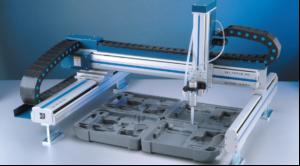

|
Edward Lowton
Editor |


|
| Home> | Production Engineering | >Automation | >Small robots big on functionality |
ARTICLE
Small robots big on functionality
25 January 2013
Benchtop robots achieve a high level of functionality, are readily available, simple to implement and inexpensive. Peter Swanson, managing director of Intertronics explains Large multi-axis robots are familiar - we

Benchtop robots achieve a high level of functionality, are
readily available, simple to implement and inexpensive.
Peter Swanson, managing director of Intertronics explains
Large multi-axis robots are familiar - we see them on television welding or spraying cars.What may not be so familiar is the success of smaller benchtop robots, which since the mid-1990s have taken on assembly tasks on more modestly sized products, and in some SMEs are now a significant factor in regeneration of UK manufacturing industries.
Small robots with footprints about A4 in size and working areas of 200 x 200mm have all the functionality of large machines. Bigger versions cover 800 x 600mm with a Z-axis of 200mm. They are fit for shop floor use and maintenance is relatively simple - often with internal computers and self-diagnostic protocols.
Typically, programming is via a simple teach pendant with prompted inputs, and programs are stored internally or kept on a computer. Software may be generic, allowing programmer control of functionality, or function specific (eg dispensing).
Customised software is user-friendly, with selectable point-to-point or continuous path motion.While 2-axis machines are available, 3-axis are the most popular, with full interpolation of lines, arcs and circles through all three axes. A fourth, rotational axis is used for more complex, non-planar jobs. Positional repeatability is typically 0.01mm and movement speeds can reach 1m/sec. Inputs and outputs allow interfacing with external devices (eg pick and place pneumatics). Sophisticated camera-based position correction systems are now available. Types include: Semi-automatic, cartesian robot - the work is placed on a moving plate on the bed of the machine, which provides x-axis movement. Overhead, a beam mounted traveller gives the y- and z-axis movement.
SCARA robot - Selectively-Compliant- Articulated-Robot-Arm, or sometimes Selective-Compliant-Assembly-Robot- Arm.With joints much like a human arm (shoulder, elbow and wrist axes), it performs pick/place, palletising or dispensing functions.
Gantry robot - an overhead beam moves back and forth over the work on a fixed base. A z-axis component slides on the gantry.
All types are suitable for semi-automatic batch operation, where the work is manually loaded/unloaded. The SCARA and gantry types will also work with automatic feed by, for example, being placed next to or over a conveyor.
Typical applications include: Dispensing, soldering, brazing, welding, pick and place, screwdriving, engraving, cutting, testing and calibration, and dispensing. Adhesives, sealants, encapsulants, potting compounds, coatings, inks, paints, greases, oils, solder pastes, and so on may be accurately metered onto workpieces - dispensed from barrels or cartridges mounted on the machine z-axis, or remotely located and fed through a robot mounted dispensing valve. Beads, coatings or micro-dots are common.Metering and mixing equipment can be interfaced to dispense two-part systems.
One popular application is the dispensing of form-in-place (FIP) gaskets onto a component, which then cures into a soft, sealing gasket. The bead must be the same diameter over its entire length, and so the dispense needle travel-speed must match the FIP gasket flow rate, even around corners in three dimensions. A robot can be programmed to do this, whereas a human would find it impossible.
Test & calibration Typically a camera is sequentially positioned over a number of small parts. The image is then examined by computer, to detect a pass or fail. Reject parts may be identified, marked or removed while on the robot.
Probes can be accurately positioned to measure electrical or thermal characteristics: eg thermostat calibration - using a robot, interfaced to the testing equipment, which adjusts the calibration screw until the appropriate electrical output is achieved.
Benefits claimed include Quality - robots are accurate and do not get distracted. Product integrity is enhanced.
Production yield - generally reject rates go down.
Throughput - robots can work continuously and can be faster than humans Necessity - sometimes the job just cannot be accomplished by a human.
Material savings - Expensive materials are dispensed accurately and multi-part material mixing may require purging or nozzle changes unless dispensed continuously.
Benchtop robots achieve a high level of functionality, are readily available, simple to implement (no need to understand robot/ machine language/PLC programming and no previous experience required). Prices start at about £4000. At this level, cost justification resulting from higher throughput and yields, fewer rejects, better quality or reduced labour content is relatively straightforward.
Payback can be as little as six months - vital to companies who would like to see domestic manufacturing both stay in the UK, and lead the economic recovery.
Peter Swanson, managing director of Intertronics explains
Large multi-axis robots are familiar - we see them on television welding or spraying cars.What may not be so familiar is the success of smaller benchtop robots, which since the mid-1990s have taken on assembly tasks on more modestly sized products, and in some SMEs are now a significant factor in regeneration of UK manufacturing industries.
Small robots with footprints about A4 in size and working areas of 200 x 200mm have all the functionality of large machines. Bigger versions cover 800 x 600mm with a Z-axis of 200mm. They are fit for shop floor use and maintenance is relatively simple - often with internal computers and self-diagnostic protocols.
Typically, programming is via a simple teach pendant with prompted inputs, and programs are stored internally or kept on a computer. Software may be generic, allowing programmer control of functionality, or function specific (eg dispensing).
Customised software is user-friendly, with selectable point-to-point or continuous path motion.While 2-axis machines are available, 3-axis are the most popular, with full interpolation of lines, arcs and circles through all three axes. A fourth, rotational axis is used for more complex, non-planar jobs. Positional repeatability is typically 0.01mm and movement speeds can reach 1m/sec. Inputs and outputs allow interfacing with external devices (eg pick and place pneumatics). Sophisticated camera-based position correction systems are now available. Types include: Semi-automatic, cartesian robot - the work is placed on a moving plate on the bed of the machine, which provides x-axis movement. Overhead, a beam mounted traveller gives the y- and z-axis movement.
SCARA robot - Selectively-Compliant- Articulated-Robot-Arm, or sometimes Selective-Compliant-Assembly-Robot- Arm.With joints much like a human arm (shoulder, elbow and wrist axes), it performs pick/place, palletising or dispensing functions.
Gantry robot - an overhead beam moves back and forth over the work on a fixed base. A z-axis component slides on the gantry.
All types are suitable for semi-automatic batch operation, where the work is manually loaded/unloaded. The SCARA and gantry types will also work with automatic feed by, for example, being placed next to or over a conveyor.
Typical applications include: Dispensing, soldering, brazing, welding, pick and place, screwdriving, engraving, cutting, testing and calibration, and dispensing. Adhesives, sealants, encapsulants, potting compounds, coatings, inks, paints, greases, oils, solder pastes, and so on may be accurately metered onto workpieces - dispensed from barrels or cartridges mounted on the machine z-axis, or remotely located and fed through a robot mounted dispensing valve. Beads, coatings or micro-dots are common.Metering and mixing equipment can be interfaced to dispense two-part systems.
One popular application is the dispensing of form-in-place (FIP) gaskets onto a component, which then cures into a soft, sealing gasket. The bead must be the same diameter over its entire length, and so the dispense needle travel-speed must match the FIP gasket flow rate, even around corners in three dimensions. A robot can be programmed to do this, whereas a human would find it impossible.
Test & calibration Typically a camera is sequentially positioned over a number of small parts. The image is then examined by computer, to detect a pass or fail. Reject parts may be identified, marked or removed while on the robot.
Probes can be accurately positioned to measure electrical or thermal characteristics: eg thermostat calibration - using a robot, interfaced to the testing equipment, which adjusts the calibration screw until the appropriate electrical output is achieved.
Benefits claimed include Quality - robots are accurate and do not get distracted. Product integrity is enhanced.
Production yield - generally reject rates go down.
Throughput - robots can work continuously and can be faster than humans Necessity - sometimes the job just cannot be accomplished by a human.
Material savings - Expensive materials are dispensed accurately and multi-part material mixing may require purging or nozzle changes unless dispensed continuously.
Benchtop robots achieve a high level of functionality, are readily available, simple to implement (no need to understand robot/ machine language/PLC programming and no previous experience required). Prices start at about £4000. At this level, cost justification resulting from higher throughput and yields, fewer rejects, better quality or reduced labour content is relatively straightforward.
Payback can be as little as six months - vital to companies who would like to see domestic manufacturing both stay in the UK, and lead the economic recovery.
MORE FROM THIS COMPANY
RELATED ARTICLES
OTHER ARTICLES IN THIS SECTION

















